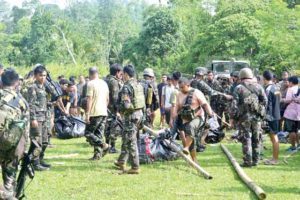ELEVEN members of the Abu Sayyaf Group including a sub-leader were killed while 17 soldiers were wounded during a firefight in Patikul, Sulu on Friday, a day after the President ordered the military to crush the terror and kidnapping group for beheading a Filipino hostage.
The clash, said Maj. Felimon Tan, spokesman of the Armed Forces of the Philippines’ Western Mindanao
Command (Westmincom), occurred at 6:12 a.m. Friday.
Members of the Joint Task Group Sulu and the 4th Scout Ranger Battalion were on combat operations when they encountered more than 100 Abu Sayyaf at Sitio Makaita in the village of Bunkaong in Patikul town.
The firefight, which lasted for 45 minutes, resulted in the killing of 10 Abu Sayyaf members who were not identified, and their sub-leader Mohammad Said who has five warrants of arrest for murder.
Scores of Abu Sayyaf members were also wounded, said Tan.
The wounded soldiers, the official said, were evacuated from the encounter site. As of Friday afternoon, government forces were pursuing the bandits.
There were no reports on the group’s Malaysian, Indonesian and Filipino hostages, as well as Norwegian national Kjartan Sekkingstad.
The intense firefight happened two days after the Abu Sayyaf beheaded 18-year-old Patrick Almodovar, one of its Filipino hostages, after his family failed to meet the August 24 deadline set by the group to pay ransom.
The Abu Sayyaf, which is still holding more than a dozen hostages, demanded P1 million.
Almodovar’s severed head, wrapped in a plastic bag, was recovered in the village of Kadjatan also in Indanan town, but his body was missing.
President Rodrigo Duterte, in a news conference in Davao City early on Thursday, vowed to be “harsh” in going after the terrorist group.
“My orders to the police and to the Armed Forces against all enemies of the state, seek them out in their lairs, whatever, and destroy them,” the President said.
The Abu Sayyaf is a loose network of a few hundred Islamic militants formed in the 1990s with seed money from Osama bin Laden’s Al-Qaeda network, and has earned millions of dollars from kidnappings-for-ransom.
Its leaders have pledged allegiance to the Islamic State group but analysts say they are mainly focused on lucrative kidnappings.
No-ransom policy
Malacañang on Friday stood by the government’s no-ransom policy following Duterte’s revelation that ransom had been paid to the Abu Sayyaf for the freedom of the Norwegian hostage Sekkingstad.
Speaking to reporters, presidential spokesman Ernesto Abella said the P50-million ransom paid to the terrorist group was not from the government.
“I’m not privy to that. But it was, I think, it was also raised by third parties, not from the government,” Abella said.
Duterte accidentally revealed on Thursday that P50 million had been paid to the Abu Sayyaf group for the freedom of Sekkingstad.
But Abella maintained that the government did not want to encourage others to pay ransom money.
“We don’t encourage. If they [engage in negotiation], that is their negotiation,” Abella said, adding that government forces were “working quietly” for the release of the Norwegian hostage.
The Abu Sayyaf earlier beheaded two Canadians—John Ridsdel, 68, in April and Robert Hall, 50, in June.
The group kidnapped the two Canadians, Sekkingstad and Filipina Marites Flor from a high-end resort on Samal Island in Davao del Norte in September last year.
Flor was released by the group in June following a successful negotiation led by former Sulu Governor Sakur Tan and Presidential Peace Adviser Jesus Dureza, who were tapped by Duterte to secure the woman.



